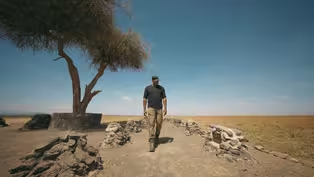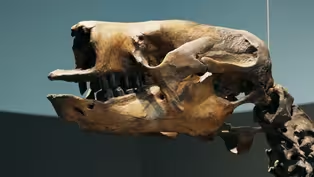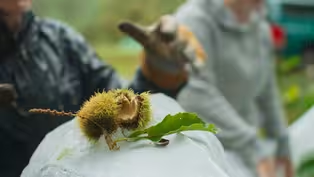
Can We Live with Giants?
Clip: Season 2 Episode 6 | 5m 14sVideo has Closed Captions
Kenyan farmers and rangers balance danger and devotion in their fight to coexist with elephants.
In Kenya, elephants and humans often live side-by-side — but not always peacefully. Shane meets David Mwiti, a farmer impacted by crop-raiding elephants, and John Pameri, a security expert at Lewa Wildlife Conservancy, who helps prevent conflict. With fences, GPS collars, and deep community investment, Lewa is rewriting the rules of coexistence between people and megafauna.
Problems playing video? | Closed Captioning Feedback
Problems playing video? | Closed Captioning Feedback

Can We Live with Giants?
Clip: Season 2 Episode 6 | 5m 14sVideo has Closed Captions
In Kenya, elephants and humans often live side-by-side — but not always peacefully. Shane meets David Mwiti, a farmer impacted by crop-raiding elephants, and John Pameri, a security expert at Lewa Wildlife Conservancy, who helps prevent conflict. With fences, GPS collars, and deep community investment, Lewa is rewriting the rules of coexistence between people and megafauna.
Problems playing video? | Closed Captioning Feedback
How to Watch Human Footprint
Human Footprint is available to stream on pbs.org and the free PBS App, available on iPhone, Apple TV, Android TV, Android smartphones, Amazon Fire TV, Amazon Fire Tablet, Roku, Samsung Smart TV, and Vizio.
Buy Now

Surprising Moments from Human Footprint
Do you think you know what it means to be human? In Human Footprint, Biologist Shane Campbell-Staton asks us all to think again. As he discovers, the story of our impact on the world around us is more complicated — and much more surprising — than you might realize.Providing Support for PBS.org
Learn Moreabout PBS online sponsorship(soft mysterious music) ♪ (Shane) African elephants are among the woolly mammoth’s closest living relatives.
And a big reason why they’re endangered is that they’re not so easy to live with.
Just ask folks in Kenya who have them as neighbors.
David Mwiti has been farming on the edge of Kenya’s Lewa Wildlife Conservancy for 30 years.
(hip-hop music) ♪ Most of his neighbors rely on their farms to make a living.
So, when elephants raid their fields, the results can be devastating.
Whoa.
And hungry elephants aren’t just destructive, they’re dangerous.
-Okay.
-Yeah.
(Shane) But everything’s different now.
(serene music) Okay.
This electrified fence keeps most elephants out of the village and out of harm’s way.
Nearby, an elephant underpass prevents deadly vehicle collisions on the highway.
These huge infrastructure investments are part of a bigger strategy to make human-elephant coexistence possible.
(hip-hop music) ♪ Meet John Pameri, head of general security at Lewa Conservancy.
The way John takes care of himself, you’d never know he’s been working here for 30 years.
♪ As human and elephant populations have grown, managing conflict between the two has gotten more demanding.
Some elephants cause more problems than others.
(elephant trumpeting) GPS collars allow the team to monitor the habitual troublemakers 24/7.
Yeah.
(calm music) (speaking foreign language) That monitoring effort is just one part of a comprehensive security operation that John oversees.
(phone beeping) When the call comes in, a human-wildlife conflict team deploys to defuse the situation before it escalates.
The ops room can also rapidly mobilize anti-poaching units.
But Lewa’s strategy isn’t just reactive, it’s proactive, too.
The Conservancy has spent decades building goodwill with the surrounding communities-- digging wells, constructing schools, and creating good, reliable jobs, all funded by conservation.
It’s been really successful, but also hugely expensive.
If the elephants were gone, do you think farmers, like, would they be upset about it?
Would they be happy about it?
It all makes me think again about mammoths.
(deeply percussive music) If we brought them back, could we coexist with them?
Mmm.
Here in Kenya, people are keeping megafauna alive in a fast-changing world.
But it means doing things differently.
Video has Closed Captions
Preview: S2 Ep6 | 30s | Shane meets species on the brink of oblivion, and the people who won’t let them slip away. (30s)
Fossils in the Asphalt: Unearthing LA’s Ancient Past
Video has Closed Captions
Clip: S2 Ep6 | 3m 5s | At La Brea Tar Pits, Emily Lindsey digs into Ice Age life beneath LA’s surface. (3m 5s)
The Ghost Tree: Bringing Back the American Chestnut
Video has Closed Captions
Clip: S2 Ep6 | 8m 15s | Sara Fitzsimmons fights to resurrect a tree that once ruled the eastern U.S. forests. (8m 15s)
The Northern White Rhino Rescue Mission
Video has Closed Captions
Clip: S2 Ep6 | 11m 4s | Scientists fight to revive the northern white rhino — before it’s too late. (11m 4s)
Orca SOS: Sniffing Out Clues to Save the Southern Residents
Video has Closed Captions
Clip: S2 Ep6 | 3m 7s | Deborah Giles and her dog Eba track whale poop to help save endangered orcas. (3m 7s)
Providing Support for PBS.org
Learn Moreabout PBS online sponsorship
- Science and Nature

Capturing the splendor of the natural world, from the African plains to the Antarctic ice.

- Science and Nature

Explore scientific discoveries on television's most acclaimed science documentary series.
Winnipeg In Bloom











Support for PBS provided by:




